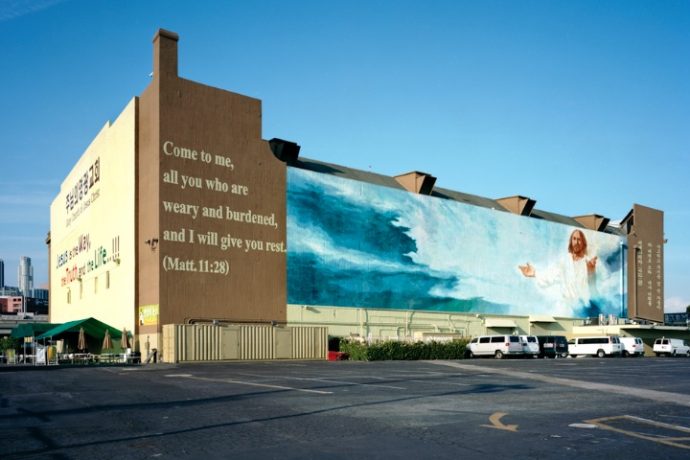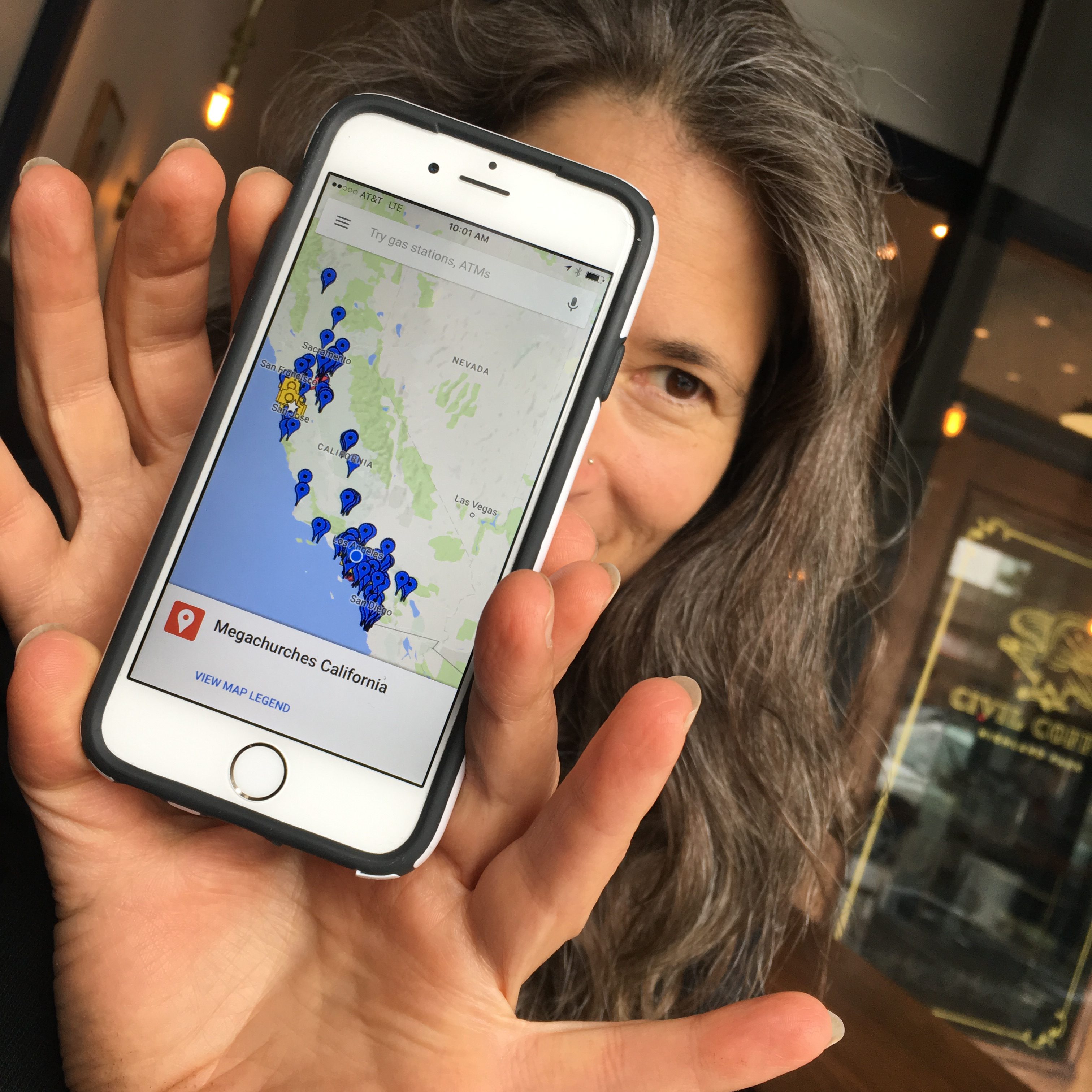Don’t tell the monsignor at St. Monica, but I visited a megachurch once.
As I wrestled with doubt about my decision that Sunday morning, a friend dragged me past the smiling welcome team, the coffee shop, the panini cart (!) and the daycare center towards the booming speakers of an arena-sized auditorium.
I didn’t renounce my Catholicism that day, but did leave with a free t-shirt, a key chain, and a couple of nifty pens I swiped from the visitors’ table. (Catholics churches should step up the free swag factor.)
Now driving through Northeast Los Angeles, I pass about half a dozen churches of sundry shapes and sizes. Some are storefront establishments, others steepled behemoths you can spot from the 110. Some are older and rooted, like the Iglesia Pentecostal Esmirna, others newer, like the recently planted Gold Line Church, named for the metro light rail that runs through the neighborhood.
The architecture of these buildings often communicates much more about the communities they serve than a mission statement ever could.
These local churches seem to blend into their surroundings, becoming as much a part of NELA’s landscape as the traffic and thrift stores. But megachurches aren’t too concerned with blending or subtlety, as a recent project from Los Angeles-based artist Lisa Auerbach shows. For “Megachurches,” Auerbach spent several years touring the United States and taking pictures of churches—exteriors only.
While flipping through the photos online or in one of Auerbach’s outsized “megazines,” you might think the only thing that distinguishes these places of worship from a Walmart Supercenter is a cross adorning the facade. No elaborate vaults or soaring arches here.
Though Auerbach is already well-known for her work with textiles, “Megachurches” has been making ripples in both the religion and art communities worldwide, and is currently being exhibited at the Galerie Thaddaeus Ropac Pantin in Paris.
When I entered the bustling coffeeshop in Highland Park, I found Auerbach in a dark hoodie holding a bike helmet, freshly out of teaching a class at Claremont and ordering a cortado. I sat with her and talked about art, America, and big box religion.
____________
Anita Little: So why megachurches? It seems to be a departure from your usual work in mixed media.
Lisa Auerbach: My background is photography, and I’ve been doing photography since I was a kid. The photo project I did before “Megachurches” was about small, freestanding businesses I started noticing when riding my bike around town. I was interested in them visually but also as a metaphor for a certain kind of Americanism, this idea of individuality and making your way in the world by pulling yourself up by your bootstraps.
I thought about that in conjunction with the 2008 presidential election, and how those were really strong ideas of what America was. But the other strong current of what defines America is this idea of faith and family and community that I felt was represented by this other structure.
I started reading about megachurches in the paper around that time, about this new way of worship that Americans were flocking towards. But I had never seen one. I had seen these small businesses and knew about them, but had never seen these megachurches, since I live in an urban environment, and they’re mostly in exurban or suburban environments. That’s when I started going to them and photographing them. It was a companion project to the small businesses project since they represent two distinct ideologies that form who we are as an American people. On one hand, I was really interested culturally in the faith and community represented in megachurches, but also the individualism, capitalism and personal agency represented by small businesses.
What reaction did you anticipate from people who are religious and part of the communities you’re photographing, and how is that different from the reaction you’ve gotten from people who are secular and just see it as art?
That’s a great question because it’s a question that I don’t really have the answer to. My community is not religious, and the art world is not religious. The people I came into contact with while shooting the images were all super friendly and excited about the project when I explained what I was doing. People I know who were raised in the church, but have since turned against it, were totally freaked out by it. They found it creepy. But in terms of actual religious people, I haven’t seen that much reaction yet or had those conversations.
Are you religious?
I’m Catholic. I don’t have a lot of experience with megachurches. But when I was looking through “Megachurches,” I didn’t know if the eeriness of all the images together was intentional or if it’s just an eye-of-the-beholder thing?
It just is what it is. That’s what it looks like. That’s what that strain of faith looks like. Like the look of Catholic cathedrals is very different from megachurches because there really is an idea of the divine in the architecture. Megachurches are more about having a big enough space for everyone to fit in, so it’s really not about this feeling of being small and humbled in the face of a larger power. I get a different feeling from going to a megachurch than I do from going to Notre Dame or going to an L.A. cathedral.
You mentioned possibly driving cross-country during the upcoming elections and maybe doing a megachurch series on that?
Maybe? I don’t know yet if I’m going to do that. We’ll see. I just came back from San Jose where I photographed 15 megachurches there.
Do you have any cities of interest that you’d feel most compelled to go to?
Well, Texas has a huge amount of megachurches. That’s like the biggest state for megachurches and would be an interesting addition to the project. But I’m not really sure of where I would go.
One of your megachurch “megazines” is on view at a gallery in Paris, and it made me curious about how Europeans see megachurches and “big box” religion. Do you have any idea where that fascination comes from? Does it stem from a kind of “silly Americans and their gargantuan churches” mindset?
The questions about reaction are hard for me because one difficult thing about being an artist is that there’s criticism that’s written here and there, but you don’t really get a feel for what everyone thinks of the work. There could be whole factions of people who are obsessed with it or people who are pissed off about it that I’ll never know about it. So when it comes to questions about reactions in the religious community, I don’t know those people. I don’t know if they’re talking about it.
At the opening, I did speak to maybe a dozen people who were mostly just fascinated. I think people are mostly surprised and just very curious. The biggest surprise for those who are not megachurch-goers is the idea that megachurches can exist in office parks, that the architecture and location is often like a warehouse.
I suppose Europeans are used to churches being in these super ornate spaces?
Yeah, or a place that’s really a destination. People I know go to a church because the paintings are pretty. You go because it’s a quiet contemplative space. You don’t go to church because of the service.
You try to photograph the churches when they’re deserted and empty. Is that in any way a commentary on what you feel is being offered in those churches?
No, I just didn’t want it to have a human face. I don’t want people to identify with it as “I could never go there because those people are all whatever they are.” I didn’t want people making generalizations based on the race of people, their gender, what they were wearing. I didn’t want that factoring into the sense of the space.
Leaping off of that question, do you feel the architecture of these buildings communicates the theologies of these churches in any way?
Theologies are really varied. There are a lot of different denominations that are represented. I’ve noticed for instance that Southern Baptist Convention churches are often very large versions of what you’d consider a classic Southern church to be, with white columns and red brick. They’re kind of blown up in this strange way. Most of them don’t look like typical churches, though—they look like big box stores or malls. Also there’s just so, so many domes. But it’s hard to make a generalization about what they’re preaching because I have a hard time figuring out what the differences between the ideologies are.
Do you mind sharing a little about your own religious background and how it might have informed your motivations for the project?
My parents were not very religious. I mean they were Jewish, but mostly the “ish,” like Jew-ish, culturally Jewish. I wasn’t brought up in a religious environment. I definitely look at these megachurches with interest, but not with the idea I’m trying to find a church to go to.
Do you feel that background gives you a unique perspective that someone who is religious wouldn’t have?
I’m trying very hard to make it an outsider’s view, which is why I only photograph the outside. My question always is how do these places change our landscape? It’s not a question of how I feel about this community. It’s more about the space itself and what they contribute to the sense of place.
Throughout history, there has been this relationship between religion and art and how people imagine the divine. Usually these imaginings take place within a church, but your work is interesting because it focuses on the exterior. Since you’re breaking that continuity, how do you think your work fits into that relationship of artwork and spirituality?
One thing that’s important to that question is that the church was a major patron of art for centuries, and they paid for all this art. The reason we have so many famous paintings of Jesus is because the church was paying the artists’ livelihoods. I’m sure churches are still commissioning artwork, but as a contemporary artist, that’s not my patron. When thinking about who pays for things and who funds what, you realize that’s determined what we see in art for much of history.
As we touched on earlier, in Europe, churches are celebrated as these things of beauty where you go to be contemplative. On the other hand, megachurch architecture seems at times to say more about power than beauty. What do you think these megachurches communicate about power, and what does their proliferation represent to you?
I can’t see the idea of power being taken away from European churches because those structures seem to communicate power as well. Religion, to a certain extent, is about power, and those structures usually exude authority.
There’s this book I’m reading called Blessed. It’s about the American prosperity gospel and how it started. The book talks about how, in earlier times, all agency was relegated to the divine. You can’t do anything on your own, everything is up to God’s will. But in the prosperity gospel, the agency starts with the individual. The prosperity gospel focuses on bettering yourself and harnessing the power of the divine in order to reap benefits on earth.
A lot of the churches referenced in this book are megachurches. These buildings appear to communicate a sense of individual power that’s validated by God’s power, and it seems that where the appeal lies for many.
Photography © Lisa Auerbach






